The Ultimate Guide to Software Development Life Cycle Models

Aim to launch an innovative product to conquer the SaaS market, or a successful mobile application? Start with learning the basic principles of the software development life cycle models and methodologies.
A suitable software development life cycle model is key to establishing an effective digital solution. Specifically, it is a mechanism for project tracking and control and a universal tool for improving client relations. Using an SDLC also allows you to eliminate risks that relate to exceeding the budget or deadline breaches.
If you plan to take one of the existing SDLC models as your starting point, you’ll need to understand their characteristics first. This guide will give you all the information you need about models and phases of systems development life cycles, including the answers to the following questions:
- What is the Software Development Life Cycle (SDLC)?
- What is an SDLC model?
- How many stages of software development are there?
- How many life cycle models exist?
- Which SDLC model is the best?
Get an understanding of how web projects are developed to bring your product to life and choose the best methodology for custom software development for your specific project.
What is the Software Development Life Cycle (SDLC)?
Let's begin with an SDLC definition. SDLC or the Software Development Life Cycle is a systematic, highly organized process for developing software. In other words, it is a sequence of stages for digital development and support.
SDLC starts with the decision to create a new digital product and ends when there is no longer a need for the product. It comprises a precise plan which describes how to plan, develop, alter, and maintain a software system. Every stage of the system development life cycle has its use case and results, which can influence the overall software development.
The intention in using this process is to build top-notch software that meets all customer requirements and expectations. You can set a pre-defined cost and timeframe when building the software to help you to achieve the expected results.
Essential SDLC Advantages
Still wondering why your project needs a complete software development life cycle? SDLC is crucial for launching SaaS or applications because each phase of the process will help you test your app's functionality. SDLC methodology can be compared to a jigsaw puzzle, which isn’t complete until each piece is in place.
SDLC has numerous advantages that will come in handy when developing a software system:
- the development life cycle provides a framework for basic activities and deliverables;
- it helps to create increased visibility within project planning;
- it allows you to obtain a complete picture of the development process (i.e., planning, timing, estimating, etc.);
- the SDLC mechanism enables tracking and managing of the project;
- it improves the development speed while decreasing risks related to this process;
- it helps to develop trustworthy client relations and establishes efficient communication between parties.
Knowing these SDLC advantages will help you delve deeper into the phases of a software development life cycle, which is the next topic in our guide.
What are the 7 Phases of System Development Life Cycle?
So what is SDLC process? To start a digital project, you must undertake the steps necessary for its efficient implementation. There are various opinions about SDLC phases; however, here we will highlight 7 stages of software development life cycle:
- Planning
- Gathering requirements & analysis
- Designing and prototyping
- Development
- Testing
- Implementation, deployment, and release
- Maintenance & support
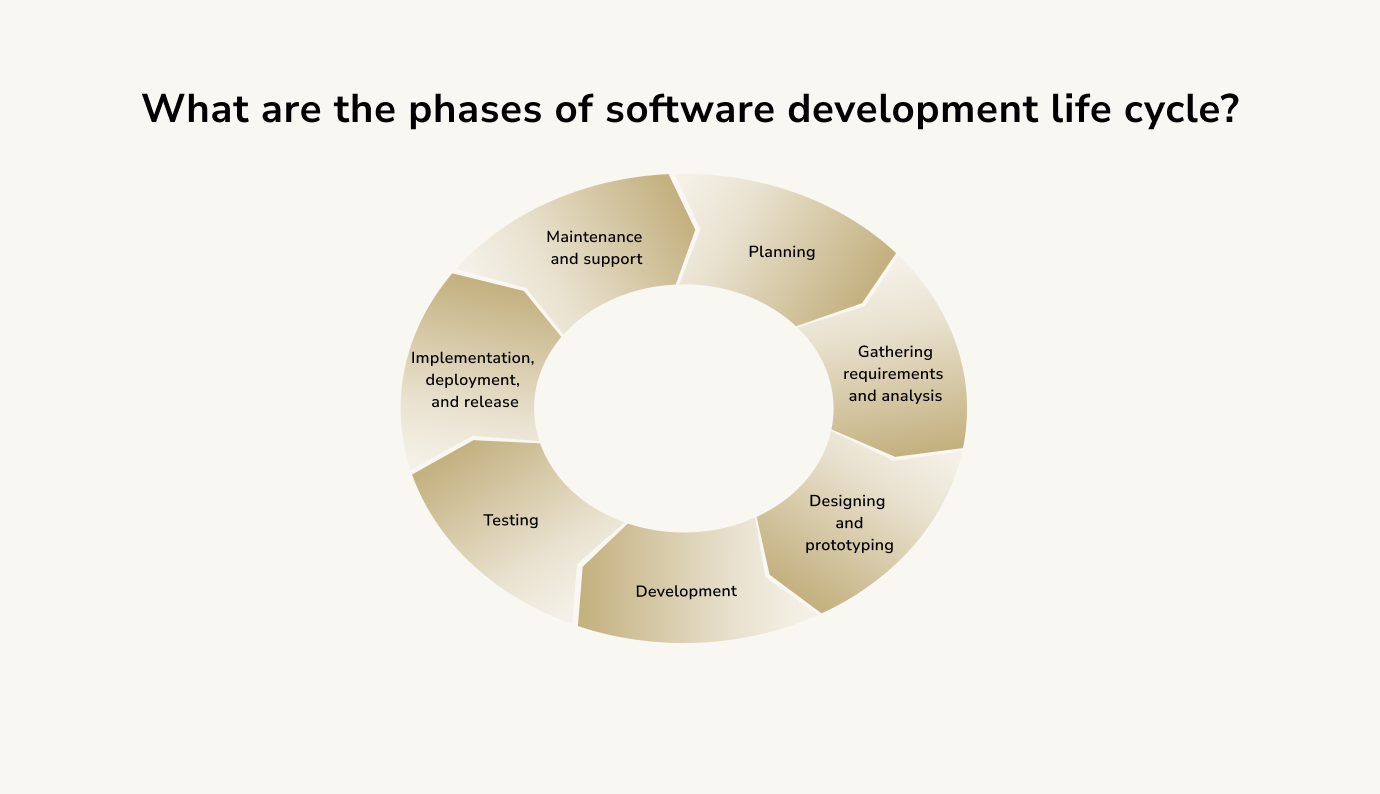
These stages of program development process are vital for software building, as each of them fulfills a specific role. To organize the process of establishing a digital product effectively, you need to analyze every stage in detail.
Phase 1: Planning
Planning phase is the first and most essential stage of software development. This SDLC phase represents gathering information relating to the long-term customer expectations and goals of the project. With a well-structured and elaborated plan, you gain a solid basis for shifting to the analysis step. The SDLC planning phase can also help you to identify the opportunities and risks of launching your application.
For example, if you want to create an app for monitoring and collecting specific data, I recommend that you indicate here what information you will need to collect to achieve the expected results. Thus, you can stay one step ahead, effectively plan the project’s growth, and spend less time on the next stages.
Phase 2: Gathering Requirements & Analysis
Now that you know what is the first step of SDLC, it's time to proceed to the next phase, which can't exist without planning.
Gathering requirements and analysis is a fundamental stage in the software development life cycle. This phase aims to define the system’s requirements to ensure that all participants in the process have a clear understanding of their objectives. To obtain the most significant benefit from the requirements phase, you should involve senior development team members, the QA specialists who can amend the process, and all other parties interested in the project.
The analysis phase helps to build up a picture of the scope, anticipated issues, and opportunities of the business. Additionally, the information gathered at this stage can be used for maintaining and supporting the product in the economic, technical, and operational areas.
The first two development life cycle phases of a systems development life cycle will help you identify your program's demands, diagnose its issues, and define the positive ways of its growth for outlining the work measurement. I would recommend you also take note of any problems that remain unresolved before proceeding to the next SDLC phase.
Phase 3: Designing and Prototyping
Moving to the design phase of SDLC reflects your readiness to optimize the project. What exactly does this entail? During design phase in SDLC, you should finalize your project's goal and define the conceptualization of the solution, which includes technologies used in the application, time frames, team load, and budget limitations. This creates an architecture for the digital application.
The designing and prototyping stage deals with custom-tailored software design to meet the specific project requirements. This process includes the development of two types of design documents:
- high-level design (HLD)
- low-level design (LLD)
HLD includes a brief description of each module and its functionality. Plus, it indicates the interface relationship, identifies database tables with their essential elements, and provides all technical details of architecture diagrams.
LLD incorporates database tables, total interface detailing, as well as input and outputs for every module. Low-level design can assess the functional logic of the modules and address diverse dependency issues.
The design phase of SDLC consists of three steps:
- Sketch
- Wireframe
- Prototype
Designers start with sketching, which provides a representation of the project's concept.
If you need to create a sketch and turn it into a digital format, the Paper app is one that I would recommend.
Once you have finished with the sketching, you'll need to transfer your draft onto a tablet to prepare a black and white model of each screen. This will be your wireframe, which will look almost like a finished design. The only missing detail will be the color scheme and actual content of the application, which can be added at the last stage of design.
In the prototyping phase, you can see how your app will actually look. This will allow you to estimate the final result and add uniqueness to your project to allow it to stand out on the market.
Phase 4: Development
After improving all the project requirements, it's time to move towards the system development phase, which actually incorporates the process of building the product. This SDLC stage entails writing the source programming code for the app.
The development step consists of two parts:
- the frontend
- the backend
The frontend is the user interface or the application that allows visitors to interact with the program. As for the backend, it represents the functionality of the app. This part guarantees the operation of the whole software system and manages all the program's functions and calculations.
The programming process includes algorithm development, source code writing, compilation, and testing.
If you have zero experience in coding, you will probably be unfamiliar with some or all of these terms. However, you can always use the assistance of a professional programmer.
Developers know how to implement the coding guidelines that govern specific programming tools, including compilers, interpreters, debuggers, and more. They also understand programming languages such as C, C++, Java, PHP, and Pascal, which are commonly used for coding.
Phase 5: Testing
Testing is one of the finalizing stages of the system development life cycle. During testing phases in software development, you can bring all the project's parts together to perform the app's debugging process.
Testing phase in SDLC includes functionality checking, systems integration, and user acceptance testing, allowing you to ensure that the code is clean and ready for establishment.
To implement this software development stage, you should place your project into a particular test environment and check it for bugs. By doing this you will have an opportunity to fix all the code flaws missed during the development phase.
Repeat the testing process until there are no critical issues related to the software workflow. This is the only way to create a product that can reach the quality standards defined in the software requirements specification (SRS).
Phase 6: Implementation / Deployment / Release
Once you get rid of all the bugs and errors detected during the testing stage, you can proceed to the implementation or deployment phase in SDLC. This phase of program development is a starting point for project realization, as it contributes to the release of the final software.
To finally launch the application on the market and showcase it to the end users, you should let your tech support team deploy the complete project. Thanks to this department, you will be able to interact with users and consult visitors about the program's execution. The implementation phase in SDLC enables updating of selected components.
Sometimes the deployment phase is realized in several steps. The developer can first release the product with limited scope to test it in a natural business environment. Then you may consider the clients' feedback in order to perform further app improvements.
Phase 7: Maintenance and Support
If you haven't upgraded your app during the deployment step, you have a great opportunity to fix this shortcoming during the maintenance phase. This is one of the most beneficial, yet potentially most expensive, stages of the system development life cycle, so do your best to take it seriously.
Maintenance is the systematic testing of a product's functionalities. It helps to identify bugs that were not detected or were not shown in the fail logs. The program's efficient operation is impossible without the vital maintenance that guarantees the project meets all requirements.
The maintenance phase of SDLC comprises the following activities:
- bug fixing process, which involves getting rid of previously undetected bugs;
- upgrading the system to newer versions of the software;
- product enhancement by adding new features into the app's design.
A focus on these three components of the maintenance SDLC phase can help to ensure the project's software performs correctly.
There are many reasons why a software system requires maintenance. One of the conditions for the improvement of design features is the desire to achieve better usability. Implementing enhancements is also an excellent reason to return to the software development life cycle's maintenance phase.
Alternative Stages of System Development Life Cycle
As well as the extended 7-step version of system development stages described in this guide, there are alternative software development life cycle concepts, with either five or six points rather than seven. The difference between these two SDLC systems may seem insignificant, but it is important to distinguish between 6-stage and 5-stage SDLC procedures.
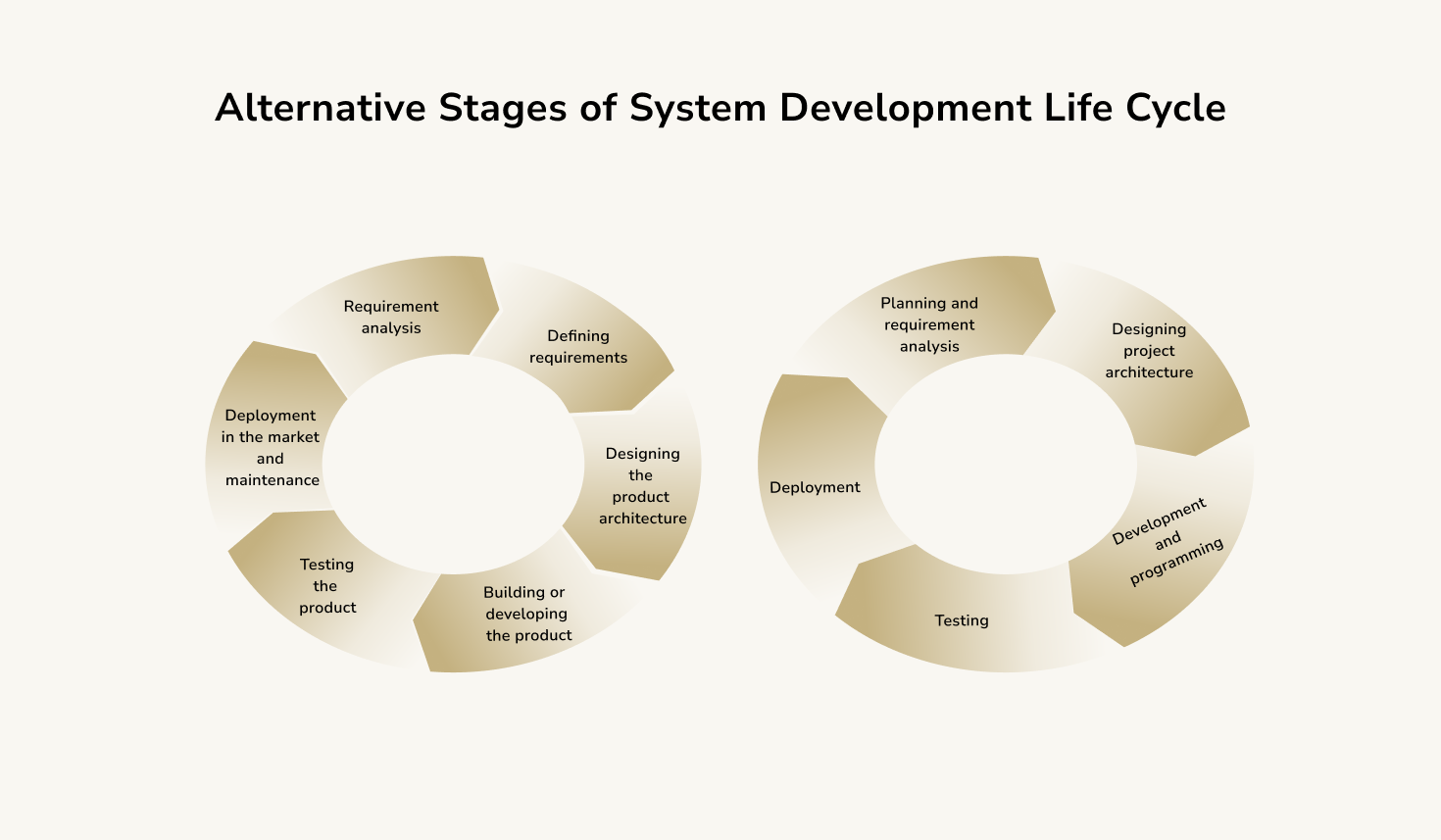
The alternative concept that includes six stages of app development lifecycle contains:
- Requirement analysis
- Defining requirements
- Designing the product architecture
- Building or developing the product
- Testing the product
- Deployment in the market and maintenance
This option, therefore, incorporates all phases except planning.
As for the 5 stages of software development, they are as follows:
- Planning and requirement analysis
- Designing project architecture
- Development and programming
- Testing
- Deployment
This option may seem less detailed, but it nevertheless provides the same functions as the 7-step scheme described in this guide. The main difference is that implementation is part of the development stage.
9 Software Development Life Cycle Models
After you have checked out how we describe the seven phases of the systems development life cycle, it's time to learn about the various types of system development methodologies. SDLC methodologies provide different ways of performing functions within each of the aforementioned stages. Developers distinguish nine software development life cycle models:
- Waterfall Model SDLC
- Iterative Model
- Agile Methodology SDLC
- Incremental Model
- Spiral Model
- V-Model
- Lean Model
- RAD Model
- Software Prototype Model
Different SDLC methodologies undertake the development process in different ways, but there is one common factor: their purpose. The system development methodologies aim to create high-quality software rapidly and efficiently.
All these types of sdlc models contain the tools needed to achieve the final goal efficiently. Still, the best choice depends on the concrete expectations and requirements. Define your intentions relating to the product and determine your project's scale and specifics to make the right decision.
You can select the appropriate SDLC model by considering the level of expertise required, time, budget, and other factors relevant to the process. However, it is advisable to understand the specifics of all software development models and methodologies in order to select the one that is the best option for your project. In the rest of this article, you'll find a detailed description of each SDLC model as well as the specific aspects of their usage.
SDLC Waterfall Model
The Waterfall software development life cycle is the first and the simplest SDLC model. This methodology looks like a flow, as its stages are closely linked and follow one another sequentially. However, take into account that Waterfall represents quite a rigid approach to software development compared to other system development methods.
The following chart illustrates the Waterfall model stages:
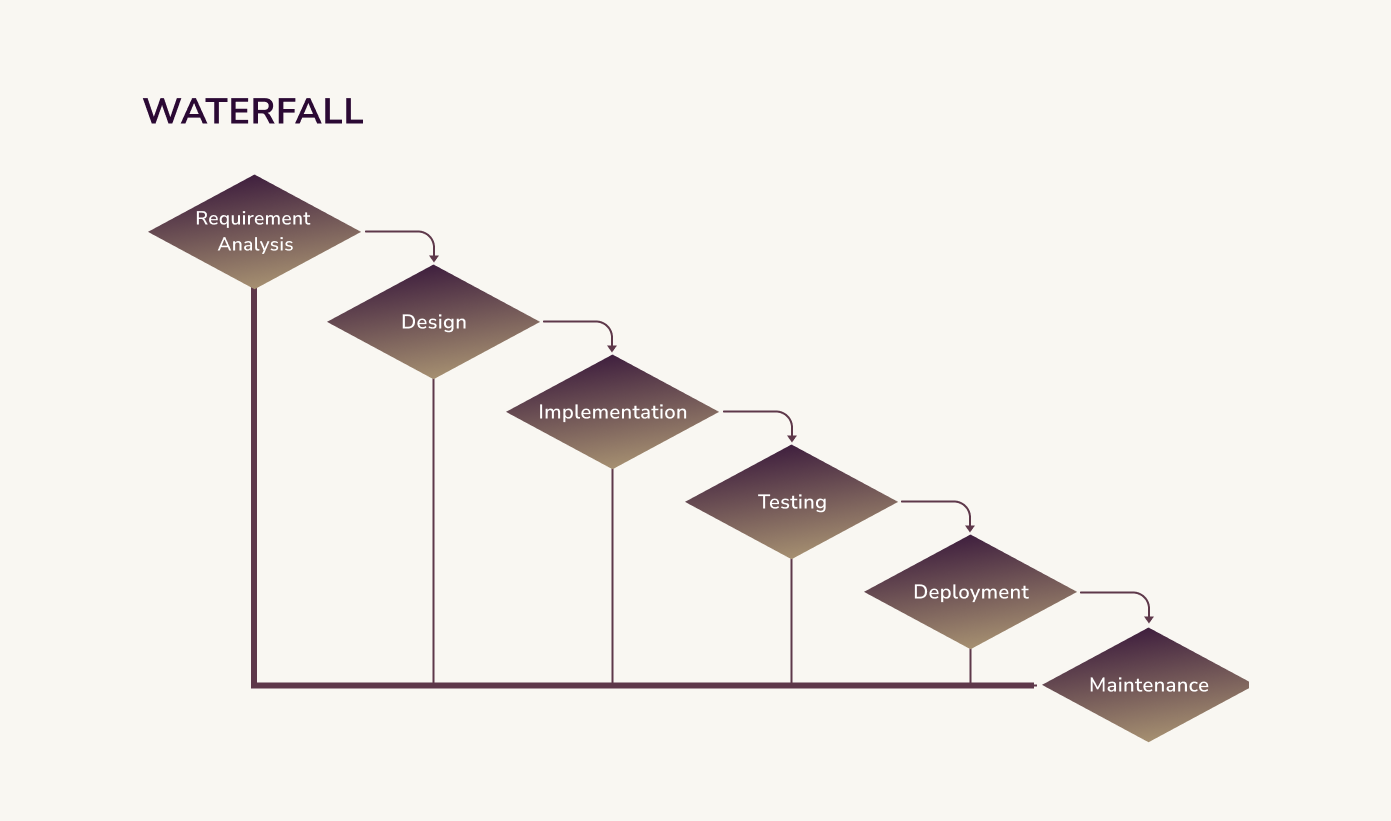
The Waterfall SDLC starts with an analysis phase to define the project's specific requirements. After a thorough requirements study comes the design phase. Then the wireframe heads to developers for implementing the code in the development stage of SDLC.
The fourth phase of Waterfall is testing for defects and bugs, which provides an estimation of the overall software performance quality. Then there is the maintenance phase, the last stage of the SDLC Waterfall model process, during which the product can be released.
In the Waterfall model system development life cycle, the outcome of one phase becomes the input for the next sequential stage. Thus, it is crucial to complete each step before proceeding to the next one. You can undertake every SDLC phase only once in this model. As the next step, let's look at the Waterfall model advantages and disadvantages.
Advantages of Waterfall lifecycle model:
- a well-structured process with a strict sequence of activities;
- easy to prioritize tasks and set accurate deadlines;
- an opportunity to test each stage before its completion;
- every phase of the Waterfall project examples has a concrete result and a defined review process.
Waterfall disadvantages:
- a lack of flexibility;
- high risks;
- inappropriate for projects with a long-term focus;
- Waterfall lifecycle model in software engineering doesn't provide the possibility to detect the strengths and weaknesses of the project before its launch.
Use Cases for the Waterfall SDLC Model
- The product's requirements are accurately documented.
- The project definition is stable and reliable.
- All requirements are precise and understandable.
- The project's intention is to be short-term.
- The technology stack is predefined.
V-Model
V-model is an extension of the aforementioned Waterfall methodology SDLC. This SDLC model incorporates testing, also known as "verification" steps, into every phase. To understand this method better, check out the following v model diagram:
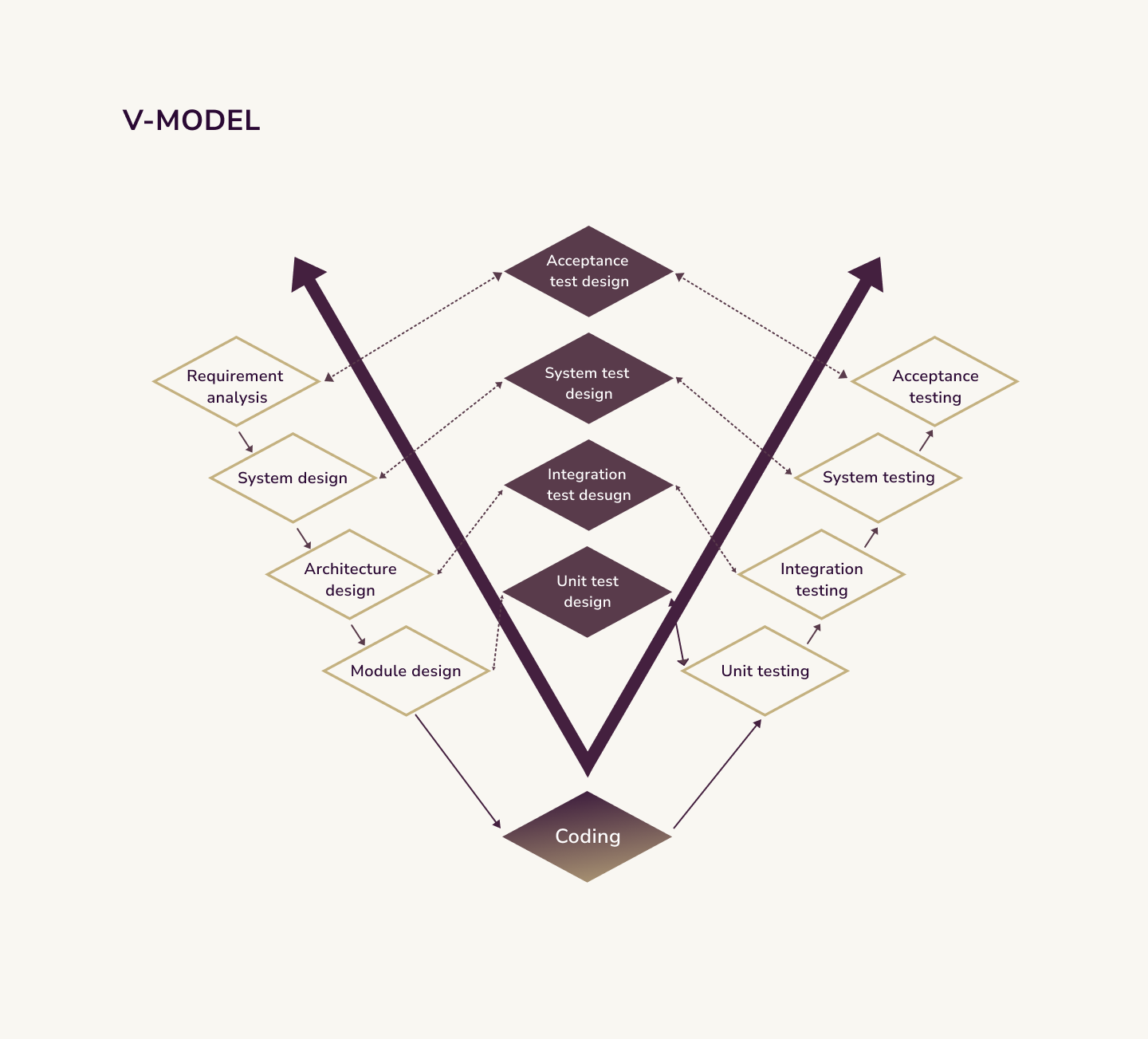
The V Model comprises several validation stages, such as:
- Business Requirement Analysis;
- Architectural Design;
- System Design;
- Module Design;
- Coding Phase.
V model development includes various testing options, which perform several functions:
- Unit testing carries out testing at code level, which helps to dispose of bugs at an early stage of the software development life cycle.
- Integration testing occurs at the stage of architecture design and performs verification of the internal modules.
- System testing verifies the software functionality and determines the level of its interaction with external modules.
- Acceptance testing improves the load and performance of the software and uncovers its compatibility with other systems.
Pros
- minimal risks;
- easy to understand and simple to manage;
- all the V model software development stages follow one another in strict order.
Cons
- time-consuming development;
- no risk analysis actions;
- V model of software development is hard to modify once it is in the v model testing stage.
Use Cases for the V-Model
- The project requires accurate product testing.
- Requirements for the product’s development are clear and well understood.
- The project is designed for the short term.
Incremental Model
The Incremental model of the software development life cycle is linear, therefore, all development life cycle phases follow each other. This system development methodology consists of mini-projects, each of which leads to a full-fledged product. Once all these systems are put together into a final software system, the product is ready to be launched.
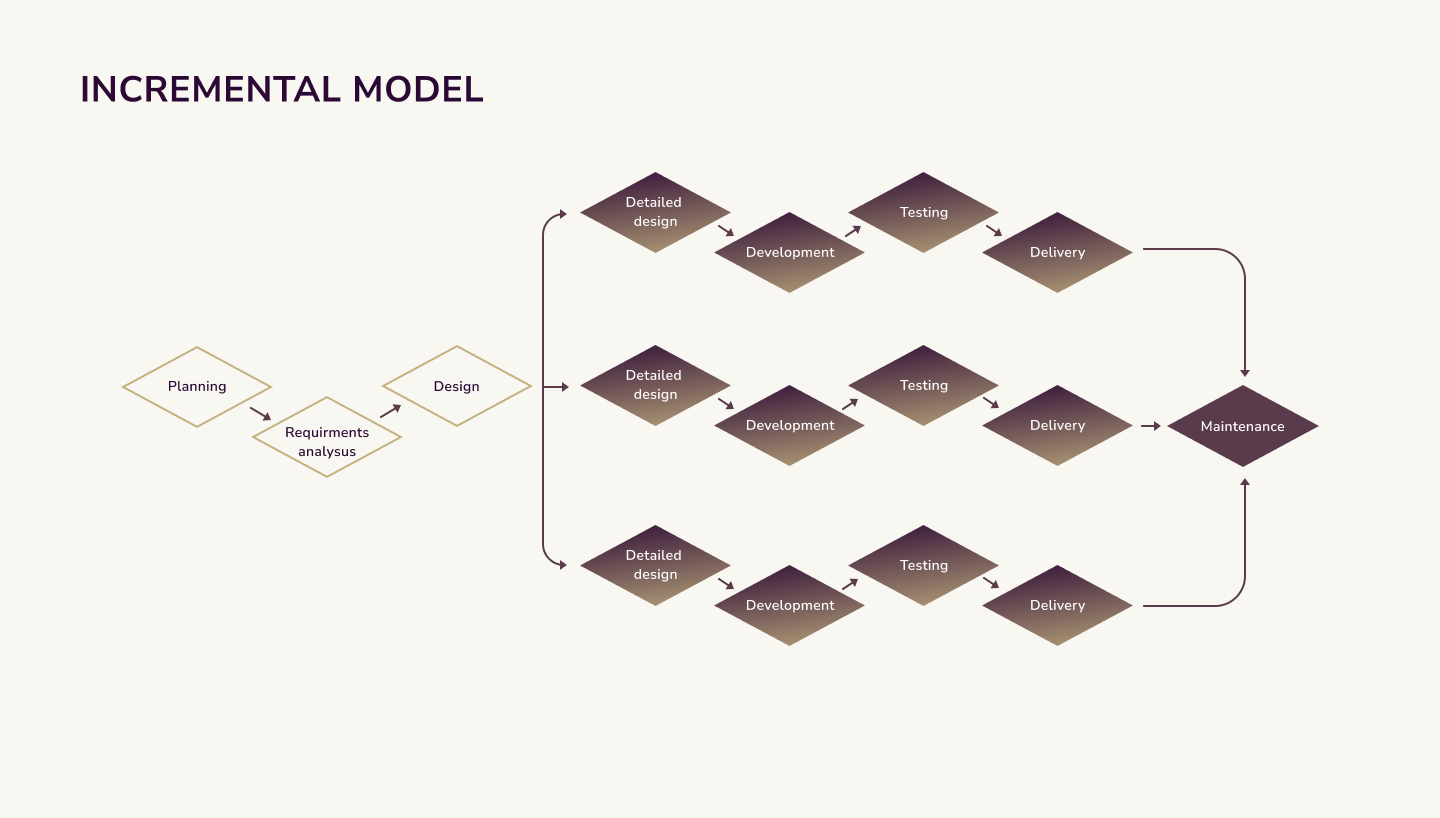
The Incremental model involves four steps in software development:
- Requirement Analysis
- Design
- Coding
- Testing
Pros
- a gradual adjustment to new technologies;
- flexibility to changes in requirements;
- the Incremental model helps to predict risks related to the project's budget.
Cons
- program development stages are rigid and relatively difficult;
- problems can cause damage to the system architecture;
- the Incremental model requires an excellent project plan and design.
Use Cases for the Incremental Model
- There is a clear understanding of all the system's requirements.
- There is a clear demand for the early release of a product.
- The project relates to custom web software development companies.
SDLC Spiral Model
The Spiral model SDLC is a sequence of iterative and linear development stages, focusing on analysis. There are four Spiral model phases:
- Identification
- Risk Analysis
- Design
- Development & Testing
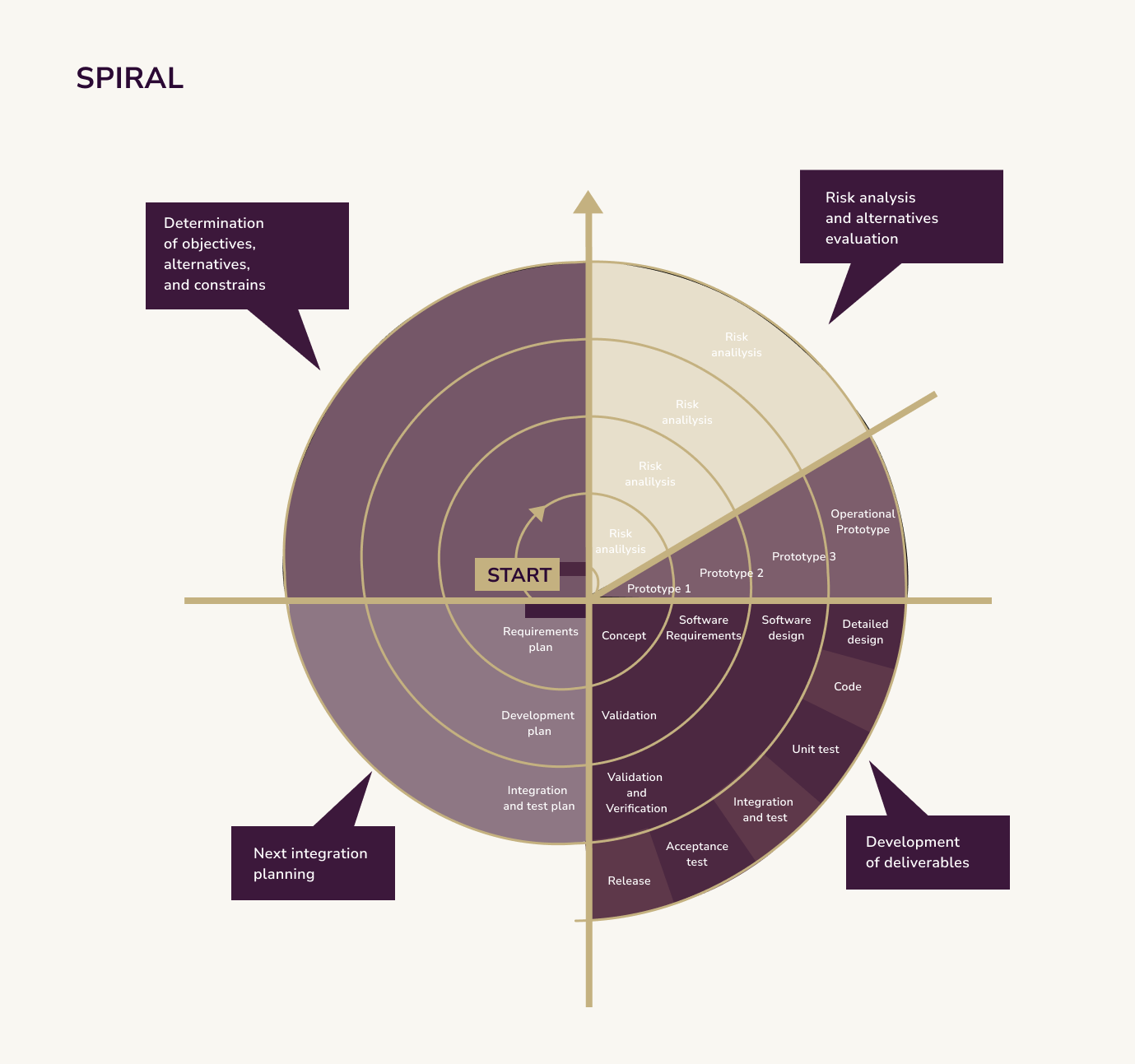
Spiral model in software engineering is the most flexible out of all SDLC methodologies, as it combines the features of both the SDLC methodology Waterfall and Prototyping approaches. Spiral development model emphasizes goal definition and risk evaluation, which are vital to the implementation stage. It is also based on client assessment and includes a linear approach to customer interaction.
Pros
- flexible designing and prototyping;
- accurate capturing of requirements;
- efficient risk management.
Cons
- a more complex management system;
- no specific deadlines;
- excessive amounts of documentation.
Use Cases for the Spiral Model SDLC
The Spiral model of software development is applicable to long-term and large-scale projects.
SDLC Agile Model
The Agile SDLC combines iterative and incremental phases of software development. This Agile software development life cycle methodology maximizes the system's adaptability, which allows us to launch a product quickly and cost-effectively.
The Agile software development life cycle consists of a combination of the following stages:
- Planning
- Requirements Analysis
- Design
- Coding
- Unit Testing
- Acceptance Testing
Choose the software development life cycle Agile model if you want to develop your project through customer interaction and collaboration. This will allow you the opportunity to define proper product requirements in line with users' feedback.
Agile methodology resume is a quick response to change and continuous development, so it will boost your product during the whole SDLC process.
Agile model advantages:
- realistic approach with minimum risks and resource requirements;
- continuous communication and interaction with the customers;
- minimal rules for managing documentation.
Disadvantages of Agile:
- the Agile project life cycle requires the availability of an overall plan and rapid PM practice;
- it is dependent on interaction with users;
- lack of documentation and constant changing of requirements.
Use Cases for the Agile Model in SDLC
- Suitable for a project with changing requirements.
- An excellent solution for small and medium-scale processes.
- The Agile SDLC model is a perfect fit for companies with steadily evolving environments.
Lean Model
The Lean SDLC model focuses on software efficiency and quick delivery of the final result. This system development model includes aspects of the Agile methodology SDLC to reduce software waste and cost. In the graph below, you can see the essential principles of the Lean model.
The first principle is the eliminate waste stage that deals with wasteful features removal. Then comes the procedure of complete system optimization and the process of software structuring. The next statement of the Lean SDLC model is development team empowerment, which can help to avoid rash decision-making during product development. The application of these principles ensures quick product delivery and excellent project quality.
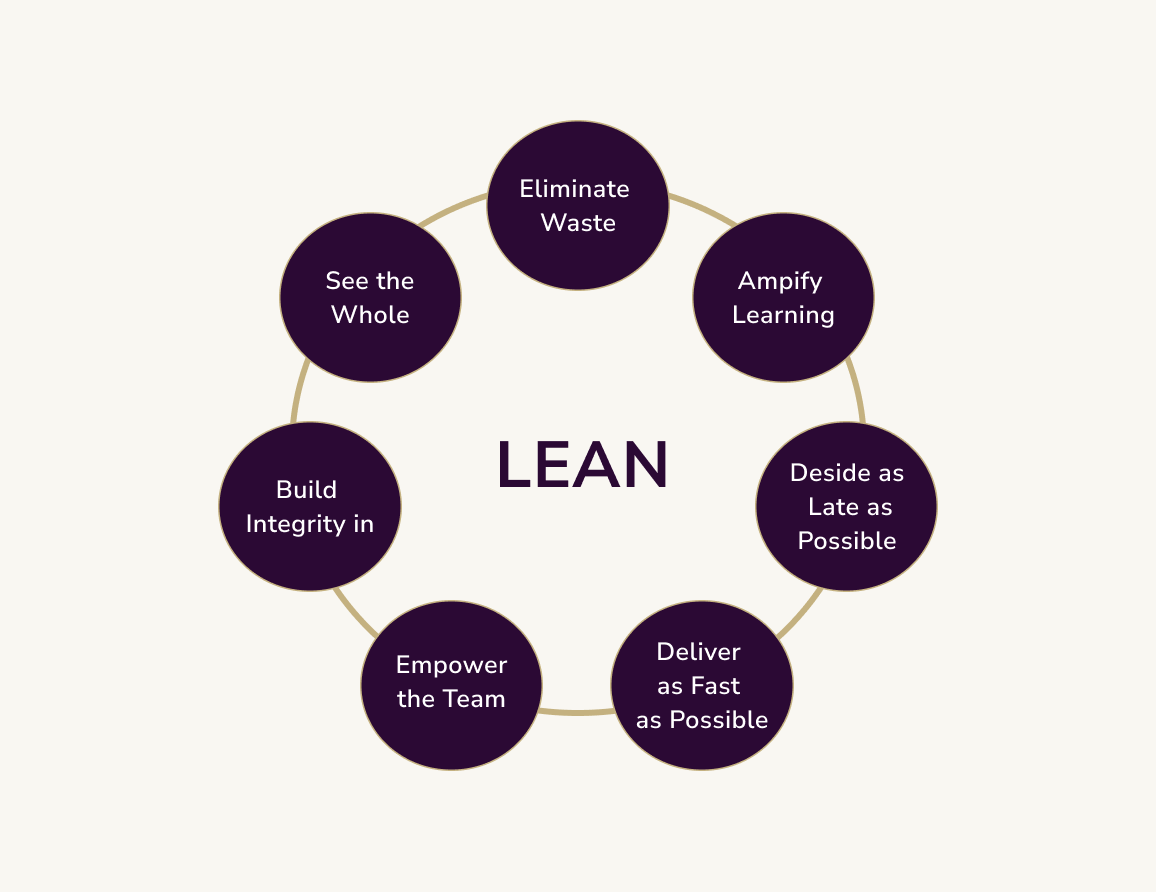
Pros
- reduced costs;
- its streamlined approach allows for delivering more functionality within a shorter time period.
Cons
- the Lean SDLC is heavily dependent on team decisions;
- less scalable than other systems;
- Lean development methodologies require strong documentation.
Use Cases for the Lean SDLC Model
- The project is built around highly motivated individuals.
- The prioritization of short-term aims and frequent interaction between users and the development team.
- The project's operation requires constant sustainable development.
Iterative Model SDLC
The Iterative models of software development life cycle deal with improving the system for its efficient deployment. This process begins with identifying part of the software for implementation of additional requirements. At the final stage of SDLC iterative model, we obtain a new version of the software. Check our iterative diagram:
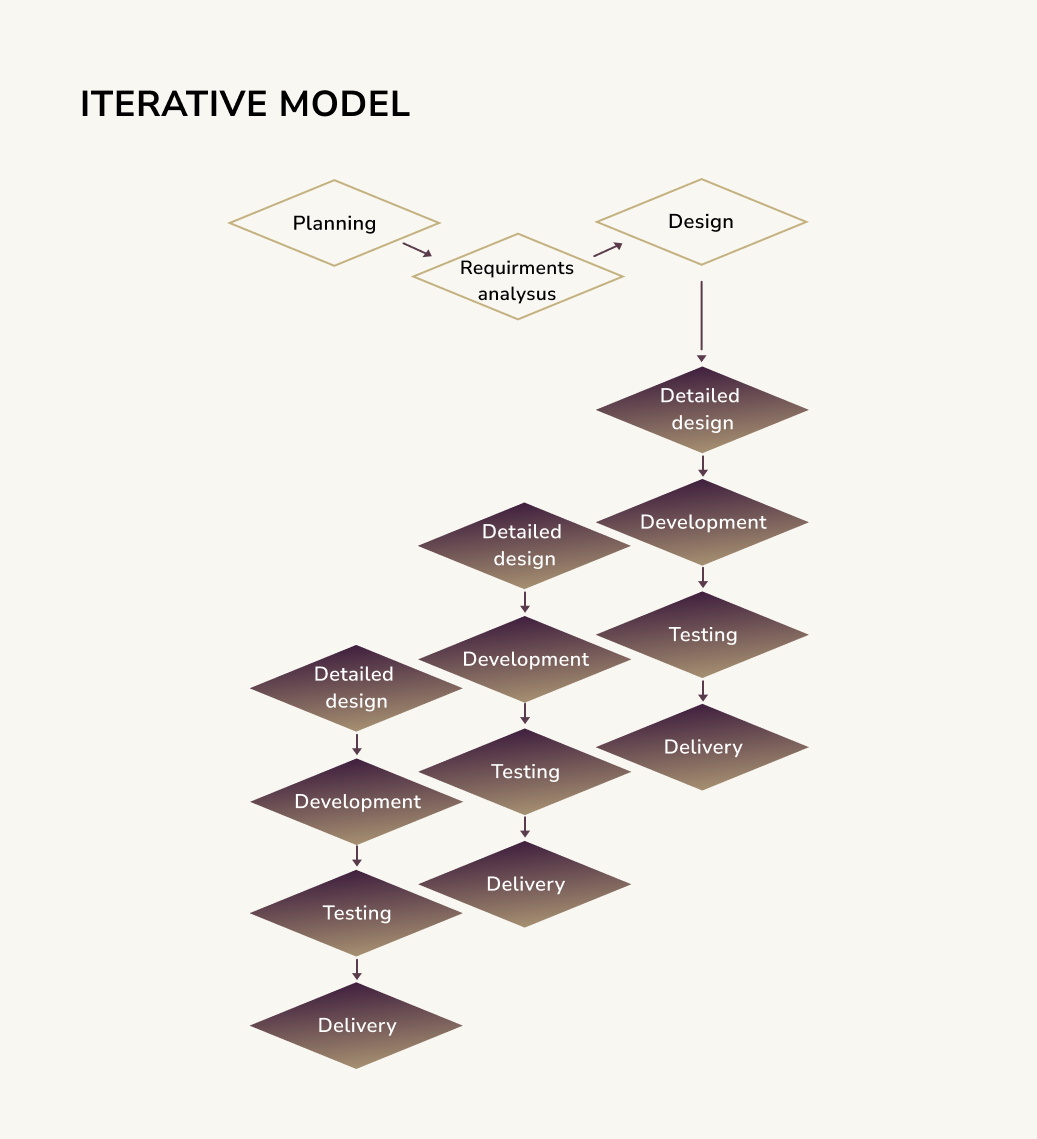
To get the most benefit from this approach, you should precisely verify and test each part of the system. However, consider the fact that your product's software must be tested repeatedly during the process of its establishment.
Pros
- the Iterative development model is easy to use;
- ability to change the project's scope and requirements at lower cost;
- easily identifies and eliminates risks.
Cons
- the iterative methodology may require additional resources in the process of software development;
- needs more management attention;
- can't analyze risks without highly skilled resources.
Use Cases for the Iterative SDLC
The Iterative methodologies are suitable for large scalable projects.
RAD Model (Rapid Application Development Model)
The Rapid Application Development model (RAD) is a program development methodology that doesn't require specific planning. This SDLC model involves creating a prototype; i.e., a working model of the product with the same functionality as the actual project.
The projects implemented using the Rapid Application Development model in SDLC follow iterative and incremental phases. Moreover, the RAD model involves stages such as:
- Business & Data Modelling
- Process Modelling
- Testing
- Turnover
Pros
- the Rapid Application Development model can measure progress through the SDLC;
- increases the reusability of software development components;
- the primary advantage of Rapid Application Development (RAD) is that it reduces the time required for the SDLC life cycle.
Cons
- requires professional developers and designers;
- dependent on Modelling skills;
- more difficult management process.
Use Cases for the Rapid Application Development Model
- Suitable only for modularized scalable systems.
- Requires user involvement within the whole software development life cycle.
- A good fit for products whose development requires shorter timelines.
Software Prototype Model
The Software Prototype Model is in demand among program developers as it helps to reveal client needs and requirements at an early stage of software launching. The software development phase allows the incorporation of users' opinions about the product, thus determining possible improvements for the project.
There are four stages of the Prototype model in software engineering:
- Requirements Identification
- Prototype Development
- Prototype Review
- Review and Enhance the Prototype
Pros
- allows increased user involvement in the project during its testing stage;
- reduces cost and time spent on SDLC;
- provides quick communication solutions for interaction with customers.
Cons
- Prototype SDLC can over-complicate the SDLC process;
- a greater number and diversity of prototypes and actual systems may confuse users.
Use Cases for the Software Prototype Model
The Prototype model in software engineering is suitable for projects with unclear or unstable requirements.
Which SDLC Model is the Best?
Selecting the best system is the first step of the systems design phase of the systems life cycle. Choosing the most appropriate SDLC model depends on the priorities of the project at hand. When it comes to your own product development, spend some time defining your business's fundamental goals and focusing on how best to implement them. No matter which software development life cycle methodology you choose, the method should resolve all issues related to your project.
Interact with the dev and QA teams to highlight the future product's essential aspects. They can provide you with actual examples of SDLC models, thus helping you to view each one from different perspectives.
Still need a consultation on the matter of the custom software development — contact us; we are always glad to assist!

Roman Zomko
Other articles